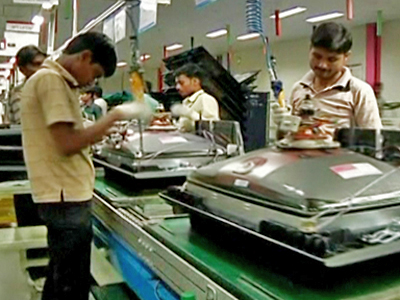
Manufacturers in India Ramping Up Operations

Before India opened up its economy, this was a rarity.
Fast-forward 20 years, and this factory outside of New Delhi is pumping out a new color TV every few seconds.
India has come a long way, says the COO of LG India.
[Yasho V. Verma, Chief Operating Officer, LG India]:
„India is known for a word in Hindi known as ‚jugaad‘: for everything to be done in a short-term way. That thinking is changing now. That’s a major shift in the manufacturing sector.“
But the Indian government wants more. The trade ministry is hoping to double exports in the next three years to offset its rising import bill and lower its big current account deficit.
Most multi-nationals have their sites firmly on the booming domestic market with exports accounting for only 5-10%.
But this is the exception the Indian government would like to see replicated.
Hyundai Motors was one of the first big foreign firms to set up a major factory in India.
Now their two plants here have become Hyundai’s largest exporting hub outside of South Korea.
One of their directors says the arrival of multinationals raised the bar on Indian production standards.
[Arvind Saxena, Director & Board Member, Hyundai India]:
„With all the advent of multinational companies in India in the last 15 or 20 years, we have started practicing lots of global practices of manufacturing, quality. So I think it’s totally different to what it was earlier.“
But is India about to become the next China-like manufacturing hub for international goods? Perennial infrastructure problems, like poor roads and not enough ports, limit exports.
And while many government policies are business friendly, others can be contradictory and the tendency of the government to make sudden changes makes it hard for companies to plan, according to GM India’s CEO.
[Karl Slym, Chief Executive Officer, GM India]:
„If you know what the outlook is what the playing field is than you can plan accordingly for that. But if you start out playing football on a football field and then all of a sudden you’re trying to play on a cricket field you’ve got the wrong equipment to be able to perform the best.“
But no company denies the huge growth of the domestic market and most say that makes it viable for them to ramp up manufacturing in the short term with an eye to increasing exports in the medium term.
The CEO of GE India says one vital change has been the improvement of local suppliers.
[John Flannery, Chief Executive Officer, GE India]:
„I’ve been here living in the country for 18 months, I’ve been coming here for 10 years, and I can tell you in the 18 months I’ve seen a huge difference. The things that we would ask or expect of our supply chain today are quite different than what we could even think about two years ago.“
And the benefits are cyclical.
The multi-nationals might be expanding their operations in India, pumping out big brand products like pink fridges popular with the Indian consumer, but there’s a whole ancillary industry that’s booming off the back of it, as local companies are increasing supplying the parts.
 Foto: NTD
Foto: NTD



























vielen Dank, dass Sie unseren Kommentar-Bereich nutzen.
Bitte verzichten Sie auf Unterstellungen, Schimpfworte, aggressive Formulierungen und Werbe-Links. Solche Kommentare werden wir nicht veröffentlichen. Dies umfasst ebenso abschweifende Kommentare, die keinen konkreten Bezug zum jeweiligen Artikel haben. Viele Kommentare waren bisher schon anregend und auf die Themen bezogen. Wir bitten Sie um eine Qualität, die den Artikeln entspricht, so haben wir alle etwas davon.
Da wir die Verantwortung für jeden veröffentlichten Kommentar tragen, geben wir Kommentare erst nach einer Prüfung frei. Je nach Aufkommen kann es deswegen zu zeitlichen Verzögerungen kommen.
Ihre Epoch Times - Redaktion